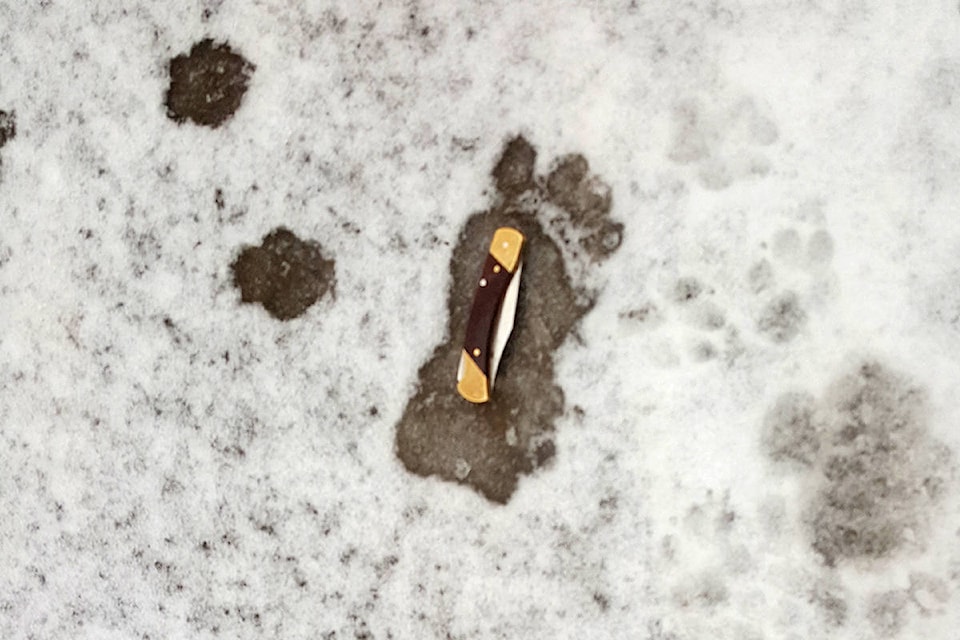They were tracks like Ken Meuckon had never seen.
Approximately 14 months ago, the resident of Coombs (near Parksville on Vancouver Island) stepped out of his house and made what he said was an odd discovery.
Just before 8 a.m. on a cold December morning, he found several large and peculiar tracks in the shallow snow on his front yard. The tracks struck him as so bizarre, Meuckon photographed them, using a closed six-inch knife for scale.
“And the weirdest thing is, they just disappeared. They suddenly stopped and didn’t go any further,” he said. “And there weren’t any claws prints in the tracks either.”
Despite the mystery, Meuckon didn’t think much of the event until recently.
Those photos remained forgotten in Meuckon’s phone, when he and his dog were outside on his property and something unseen roared loudly in their direction.
“I’ve been here 30 years and have never been scared like that,” he said.
After asking his neighbours about bears, specifically if they had seen or heard any recently, he was told they had not. Out of curiosity, Meuckon showed those forgotten photos to his neighbour and asked for his opinion, who said he had never seen tracks like that before.
Meuckon then took to the internet to continue his research, where a Facebook group called ‘’ offered him some insight. There, he said he found several other tracks similar in shape and size as his own photo.
“For over a year, I had always thought it was just a bear print. It wasn’t until I went online to see what bear prints actually looked like, and they weren’t anywhere near to what I have. And that’s when I went to the Bigfoot page for the first time in my life.”
“In Canada, we call it Sasquatch,” said , a Sasquatch researcher since 1978 and author of three books on the topic. “Bigfoot is the American name, never forget that. And before Sasquatch was coined in 1929, on Vancouver Island the term ‘Mowgli’ was used a lot. Especially by non-First Nations people on the Island.”
READ MORE:
The name Mowgli being a reference to the protagonist of Rudyard Kipling’s The Jungle Book stories.
“And just like everywhere in B.C., there’s been a long history of reported sighting on Vancouver Island,” said Steenburg.
He said some of the first sightings go as far back as the turn of the 20th century. One instance he spoke of took place in 1904, by ‘sober-minded settlers’ of the Qualicum Beach area who had been hunting in the vicinity of Horne Lake when they came upon an ‘unearthly being’ they described as a living, breathing and modern Mowgli. The settlers said the Mowgli was a wild-man, apparently young, with hair that completely covered his body, and ran like a deer.
Steenburg said much of the research on Vancouver Island was done by his late colleague, .
Bindernagel, who passed away in 2018, was a wildlife biologist who sought evidence of the Sasquatch’s existence since 1963, chiefly on the Island, and who published a book titled North America’s Great Ape: The Sasquatch in 1998.
Meuckon told PQB News he also showed his photos to a senior member at the North Island Wildlife Recovery Centre who said they believed the tracks may be an amalgamation of front and back prints of bear tracks, which would attest to their size.
B.C. Conservation Officer Andrew Riddell agreed that, upon inspection, his instinct told him they were the front and back paws of a black bear.
Meuckon said he isn’t ruling out the possibility of the tracks belonging to a bear, but isn’t ready to rule out other possibilities either.
For more news from Vancouver Island and beyond delivered daily into your inbox, please
Like us on and follow us on




